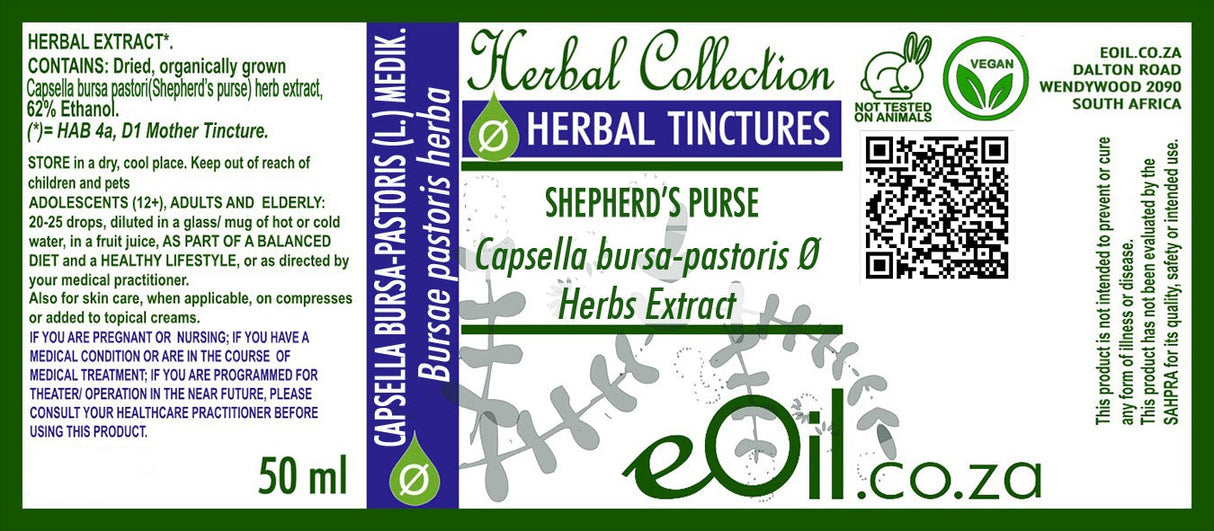Shepherd's purse Herbal Liquid Extract
Shepherd's purse Herbal Liquid Extract - 50 ML is backordered and will ship as soon as it is back in stock.
Description
Description
Understanding Mother Tinctures & Glycerines
Shepherd’s Purse Herbal Liquid Extract tincture (Capsella bursa-pastoris) is a pure, plant-based supplement traditionally valued for supporting natural menstrual balance, mild bleeding, and urinary comfort.
Known for its gentle astringent and tonic qualities, this vegan tincture is additive-free and suitable for daily wellness routines and herbal blends.
TRADITIONALLY USED FOR
Shepherd’s Purse (Capsella bursa-pastoris) Herbal Liquid Extract Tincture
Ancient field remedy for healthy cycles, gentle astringent action, and natural wound care—in a potent, fast-acting drop.
Key Benefits
- Menstrual & Uterine Support: Traditionally known for promoting menstrual comfort, reducing heavy flow, and supporting healthy uterine tone—ideal for natural period regulation or after childbirth.
- Natural Astringent & Bleeding Remedy: Used to help curb mild, non-serious internal/external bleeding (nosebleeds, minor cuts, postpartum spotting, and hemorrhoids).
- Urinary & Pelvic Wellness: Can tone and support bladder function, addressing mild incontinence and supporting postnatal recovery.
- Wound, Bruise, & Skin Support: Valued for its mild anti-inflammatory, astringent properties on topical application.
- Vegan, Pure, and Rapidly Absorbed: Faster acting than capsules or teas, easy to use wherever and whenever support is needed.
Dosage & Directions
- Adults: 1–2 ml (20–40 drops) in water, up to 3x daily as needed.
- For cycle or acute use, employ for up to 5 days at a time, then pause.
- Topical: May be dabbed (diluted) onto minor wounds or used in compresses for bruises as advised.
- Children (12+): Use half adult dose, under health practitioner guidance.
Cautions & Contraindications
- Not for use during pregnancy (may stimulate the uterus), or in chronic kidney disease.
- Discontinue in case of allergy, GI upset, or if heavy/prolonged bleeding persists (seek medical evaluation).
- Consult healthcare professional if on anticoagulants, or for regular use with chronic illness or after surgery.
Storage
- Keep tightly closed, below 25°C, out of direct light and reach of children.
Shepherd’s Purse Tincture Recap Table
| Product Type | Main Benefits | Dosage & Use | Best For | Not For / Cautions |
|---|---|---|---|---|
| Tincture | Menstrual/heavy flow support, bleeding, astringent, urinary & wound care | 1–2 ml (20–40 drops) 1–3x daily, short-term | Cycles, minor bleeds, rapid relief | Pregnancy, serious bleeding, kidney issues |
Buy shepherd’s purse tincture South Africa, Capsella bursa-pastoris menstrual support, natural period regulation drops, vegan wound care herbal, liquid herbal astringent, heavy bleeding natural remedy, plant-based pelvic support tincture.
INFORMATION
Source : http://www.wikiphyto.org/wiki/Shepherd's purse
Reference on http://www.wikiphyto.org
Translation in English by Google Translate (go to the page of the source linked | on Chrome cellphones go on the 3 dots on the top right and select translate in your preferred language | on laptop right click your mouse and select option translate when hoovering on the page
plant name
Shepherd 's purse , shepherd's purse , capsule , Capuchin purse , Judah purse , Mithriade mustard, Shepherd's purse , Shepherd's - purse ( English)
International Latin denomination
Moench pastoral scholarship. (former name: Thlaspi bursa-pastoris )
botanical family
Brassicaceae (Crucifères)
Description and habitat
- Herbaceous plant, stem with basal leaves, white flowers, heart-shaped silicles
History and tradition
- Takes its name from its heart-shaped (heart-shaped) silicles (capsules) resembling a purse
- It was used as an ersatz for goldenseal and ergot when these products were lacking during the First World War.
Parts used
- Fresh aerial parts (according to Cazin desiccation causes its properties to be lost) [1]
Dosage forms available
- Whole plant tincture
Usual dosages
Composition
Main components of the plant
- Flavonoids : quercetin , tricine , diosmetin , kaempferol , luteolin , hesperitin , cupressoflavone , swertisin , and glycosidic derivatives ( rutin , diosmin , hesperidin , luteolin-7-rutinoside , luteolin-7-galactoside , quercetin-3-rutinoside )
- Triterpene saponosides
- Glucosinolates (= sulfurized glycosides): sulforaphane , sinigrin
- Vaso-active amines: choline (0.2%), acetylcholine, histamine
- Alkaloids (traces)
- Fumaric acid ( acid alcohol )
- Phenol acids : chlorogenic acid , vanillic acid , syringic acid
- Amino acids: proline, tyramine, ornithine, peptides ( alpha-aminobutyric acid and gamma-aminobutyric acid , alpha-aminoadipic acid )
- Tannins
- Essential oil : camphor (main constituent at a concentration of 0.02% in the plant), triterpenols
- Resin, sterols , triacylglycerols
- Other constituents: carotenoids , vitamin A, ascorbic acid, vitamin K, cardenolide , calcium and potassium salts [2]
Main components of buds or young shoots
Main components of essential oil
Properties
Plant properties
- Hemostatic, astringent
- Tonic of the uterine muscle
- Venous tonic (smooth muscles)
- Anti-inflammatory and antioxidant [3] , [4]
- Acts on bacterial resistance ( Enterococcus and Bacillus anthracis resistant to vancomycin) [5]
- Anticancer (Ehrlich tumour?) by fumaric acid [6] , [7]
Bud properties
Properties of essential oil
Indications
Indications of the whole plant (phytotherapy)
- Venous insufficiency
- Meno-metrics
- Gastric ulcer
Indications of the bud (gemmotherapy)
Specific indications of essential oil (aromatherapy)
Known or suspected mode of action
- Glucosinolates ( sulphur molecules) confer effects on the hepatic, bronchial and cutaneous spheres
- Glucosinolates are hydrolyzed by an enzyme, “myrosinase” which produces sulfur and isothiocyanates
- Stimulation of smooth muscle by vasoactive amines (choline, acetylcholine, histamine)
Usual formulations
- Injectable formula usable in bleeding fibroids, which it sometimes allows to reduce the volume (according to many personal observations [8] ):
- Thlaspi bursa pastoris 3 DH
- Tormentilla 4 DH … àà QSP 1 injectable ampoule No. 12 (Weleda laboratory): One subcutaneous injection per day for the duration of menstruation, and one subcutaneous injection per week, outside of menstruation, continuously.
Regulations
- French Pharmacopoeia list A (flowering aerial part)
- Activity recognized by the German Commission E
Possible side effects and precautions for use
- Toxic in high doses
Bibliographic references
- Go↑ Cazin FJ. Practical and reasoned treatise on native medicinal plants. Ed. de l'Envol. Mane. 1997. reissue of the original from 1868. p. 212.
- Go↑ EMA European Medicine Agency. Assessment report on Capsella bursa-pastoris (L.) Medikus, herba. Committee on Herbal Medicinal Products (HMPC), EMA/HMPC/262767/2010, 12 July 2011
- Go↑ Kubínová R, Spačková V, Svajdlenka E, Lučivjanská K. Antioxidant activity of extracts and HPLC analysis of flavonoids from Capsella bursa-pastoris (L.) Medik]. Ceska Slov Farm. 2013 Aug; 62 (4): 174-6. PMID 24047146
- Go↑ Hong, J. I., Na, G. S., & Yang, H. C. (1994). Free radical scavenging and antioxidative activities by ethanol extract from Capsella bursa-pastoris. The Korean Journal of Food And Nutrition, 7(3), 169-176.
- Go↑ Choi WJ, Kim SK, Park HK, Sohn UD, Kim W. Anti-Inflammatory and Anti-Superbacterial Properties of Sulforaphane from Shepherd's Purse. Korean J Physiol Pharmacol. 2014 Feb;18(1):33-9. doi: 10.4196/kjpp.2014.18.1.33. PMID 24634594
- Go↑ Kuroda K, Akao M, Kanisawa M, Miyaki K. Inhibitory effect of Capsella bursa-pastoris extract on growth of Ehrlich solid tumor in mice. Cancer Res. 1976 Jun;36(6):1900-3. PMID 1268843
- Go↑ Tariq A, Mussarat S, Adnan M.Review on ethnomedicinal, phytochemical and pharmacological evidence of Himalayan anticancer plants.J Ethnopharmacol. 2015 Apr 22;164:96-119. doi: 10.1016/j.jep.2015.02.003. PMID 25680842
- Go↑ Jean-Michel Morel. Practical treatise on phytotherapy. Ed. Grancher, 2008.
- Bézanger-Beauquesne, Pinkas, Torck, Trottin. Medicinal plants of temperate regions. Ed. Maloine. Paris. 1980. p. 128
- Kuroda K, Takagi K. Studies on capsella bursa pastoris. I. General pharmacology of ethanol extract of the herb. Arch Int Pharmacodyn Ther. 1969 Apr;178(2):382-91. PMID 5389956
- Kuroda K, Takagi K. Studies on capsella bursa pastoris. II. Diuretic, anti-inflammatory and anti-ulcer action of ethanol extracts of the herb. Arch Int Pharmacodyn Ther. 1969 Apr;178(2):392-9. PMID 4390992
- Kuroda K, Kaku T. Pharmacological and chemical studies on the alcohol extract of Capsella bursa-pastoris. Life Sci. 1969 Feb 1;8(3):151-5. PMID 5775160
- W Zhou. Ethnobotany of Capsella bursa pastoris (L.) Medic. Journal of Plant Resources and Environment, 1998
CAUTION
Store in a cool, dry place, away from light. Keep tightly closed, away from the reach of Children and pets.
Do not exceed the daily dose.
This product is not intended to prevent or cure any form of illness or disease.
If you are pregnant or nursing ; If you have a medical condition or are in the course of medical treatment ; If you are programmed for theater/operation in the near future, please consult your healthcare practitioner before using this product.
This product cannot replace a varied and balanced diet and a healthy lifestyle.
This product has not been evaluated by the SAHPRA for its quality, safety or intended use.





